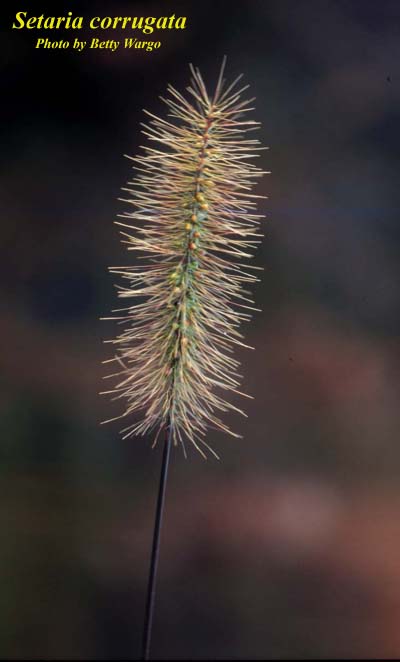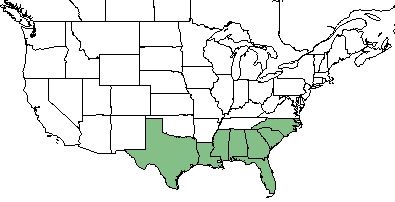Difference between revisions of "Setaria corrugata"
(→Ecology) |
HaleighJoM (talk | contribs) (→Ecology) |
||
| (12 intermediate revisions by 3 users not shown) | |||
| Line 1: | Line 1: | ||
{{italic title}} | {{italic title}} | ||
| − | Common name: coastal bristlegrass <ref name= "USDA Plant Database"/> | + | Common name: coastal bristlegrass<ref name= "USDA Plant Database"/> |
<!-- Get the taxonomy information from the NRCS Plants database --> | <!-- Get the taxonomy information from the NRCS Plants database --> | ||
{{taxobox | {{taxobox | ||
| Line 25: | Line 25: | ||
==Description== | ==Description== | ||
<!-- Basic life history facts such as annual/perrenial, monoecious/dioecious, root morphology, seed type, etc. --> | <!-- Basic life history facts such as annual/perrenial, monoecious/dioecious, root morphology, seed type, etc. --> | ||
| − | ''S. corrugata'' is an annual graminoid of the ''Poaceae'' family native to North America. <ref name= "USDA Plant Database"> USDA Plant Database [https://plants.usda.gov/core/profile?symbol=SECO4 https://plants.usda.gov/core/profile?symbol=SECO4] </ref> | + | ''S. corrugata'' is an annual graminoid of the ''Poaceae'' family native to North America.<ref name= "USDA Plant Database"> USDA Plant Database [https://plants.usda.gov/core/profile?symbol=SECO4 https://plants.usda.gov/core/profile?symbol=SECO4] </ref> |
==Distribution== | ==Distribution== | ||
| − | ''S. corrugata'' is found along the southeastern coast of the United States from Texas to North Carolina | + | ''S. corrugata'' is found along the southeastern coast of the United States from Texas to North Carolina<ref name= "USDA Plant Database"/> with disjunct populations in western Cuba.<ref>Sorrie, B. A. and A. S. Weakley 2001. Coastal Plain valcular plant endemics: Phytogeographic patterns. Castanea 66: 50-82.</ref> |
==Ecology== | ==Ecology== | ||
===Habitat=== <!--Natural communities, human disturbed habitats, topography, hydrology, soils, light, fire regime requirements for removal of competition, etc.--> | ===Habitat=== <!--Natural communities, human disturbed habitats, topography, hydrology, soils, light, fire regime requirements for removal of competition, etc.--> | ||
| − | ''S. corrugata'' proliferates in pinelands and disturbed areas. <ref name= "Weakley 2015"> Weakley, A. S. (2015). Flora of the Southern and Mid-Atlantic States. Chapel Hill, NC, University of North Carolina Herbarium. </ref> Specimens have been collected from open pineland, coastal hammocks, roadsides, banks of holding ponds, wooded old dune, sandy hardwood clearing, mixed forest, oak woods, longleaf pine sand ridge, wiregrass savanna, bluff by river, mangrove swamp, and open field. <ref name = "FSU herbarium"> URL: http://herbarium.bio.fsu.edu. Last accessed: June 2018. Collectors: R.K. Godfrey, Loran Anderson, C. Jackson, R. Kral, R. E. Perdue, Richard Houk, R. Kral, A.F. Clewell, D.L. Martin, S. T. Cooper, Gwynn Ramsey, R.S. Mitchell, J. P. Gillespie, D.B. Ward, J. Hunter, F. S. Ward, D. Burch. States and counties: Florida (Leon, Wakulla, Franklin, Santa Rosa, Gadsden, Levy, Brevard, Madison, Citrus, Sarasota, Dixie, Suwannee, Hamilton, Walton, Monroe) Georgia (Thomas)</ref> | + | ''S. corrugata'' proliferates in pinelands and disturbed areas.<ref name= "Weakley 2015"> Weakley, A. S. (2015). Flora of the Southern and Mid-Atlantic States. Chapel Hill, NC, University of North Carolina Herbarium.</ref> Specimens have been collected from open pineland, coastal hammocks, roadsides, banks of holding ponds, wooded old dune, sandy hardwood clearing, mixed forest, oak woods, longleaf pine sand ridge, wiregrass savanna, bluff by river, mangrove swamp, and open field.<ref name = "FSU herbarium"> URL: http://herbarium.bio.fsu.edu. Last accessed: June 2018. Collectors: R.K. Godfrey, Loran Anderson, C. Jackson, R. Kral, R. E. Perdue, Richard Houk, R. Kral, A.F. Clewell, D.L. Martin, S. T. Cooper, Gwynn Ramsey, R.S. Mitchell, J. P. Gillespie, D.B. Ward, J. Hunter, F. S. Ward, D. Burch. States and counties: Florida (Leon, Wakulla, Franklin, Santa Rosa, Gadsden, Levy, Brevard, Madison, Citrus, Sarasota, Dixie, Suwannee, Hamilton, Walton, Monroe) Georgia (Thomas)</ref> |
<!--===Phenology===--> <!--Timing off flowering, fruiting, seed dispersal, and environmental triggers. Cite PanFlora website if appropriate: http://www.gilnelson.com/PanFlora/ --> | <!--===Phenology===--> <!--Timing off flowering, fruiting, seed dispersal, and environmental triggers. Cite PanFlora website if appropriate: http://www.gilnelson.com/PanFlora/ --> | ||
===Seed dispersal=== | ===Seed dispersal=== | ||
| − | This species is thought to be dispersed by wind. <ref> Kirkman, L. Katherine. Unpublished database of seed dispersal mode of plants found in Coastal Plain longleaf pine-grasslands of the Jones Ecological Research Center, Georgia.</ref> | + | This species is thought to be dispersed by wind.<ref> Kirkman, L. Katherine. Unpublished database of seed dispersal mode of plants found in Coastal Plain longleaf pine-grasslands of the Jones Ecological Research Center, Georgia.</ref> |
<!--===Seed bank and germination===--> | <!--===Seed bank and germination===--> | ||
| − | + | ===Fire ecology=== <!--Fire tolerance, fire dependence, adaptive fire responses--> | |
| + | Populations of ''Setaria corrugata'' have been known to persist through repeated annual burning.<ref>Glitzenstein, J. S., D. R. Streng, R. E. Masters, K. M. Robertson and S. M. Hermann 2012. Fire-frequency effects on vegetation in north Florida pinelands: Another look at the long-term Stoddard Fire Research Plots at Tall Timbers Research Station. Forest Ecology and Management 264: 197-209.</ref><ref>Platt, W.J., R. Carter, G. Nelson, W. Baker, S. Hermann, J. Kane, L. Anderson, M. Smith, K. Robertson. 2021. Unpublished species list of Wade Tract old-growth longleaf pine savanna, Thomasville, Georgia.</ref> | ||
<!--===Pollination===--> | <!--===Pollination===--> | ||
| − | <!--=== | + | <!--===Herbivory and toxicology===<!--Common herbivores, granivory, insect hosting, poisonous chemicals, allelopathy, etc--> |
| − | <!--==Diseases and parasites==--> | + | <!--===Diseases and parasites===--> |
| − | ==Conservation and | + | ==Conservation, cultivation, and restoration== |
| + | |||
| + | ==Cultural use== | ||
| − | |||
==Photo Gallery== | ==Photo Gallery== | ||
<gallery widths=180px> | <gallery widths=180px> | ||
</gallery> | </gallery> | ||
==References and notes== | ==References and notes== | ||
Latest revision as of 12:11, 15 July 2022
Common name: coastal bristlegrass[1]
| Setaria corrugata | |
|---|---|

| |
| Photo by Betty Wargo hosted at Atlas of Florida Plants | |
| Scientific classification | |
| Kingdom: | Plantae |
| Division: | Magnoliophyta - Flowering plants |
| Class: | Liliopsida - Moncots |
| Order: | Poales |
| Family: | Poaceae |
| Genus: | Setaria |
| Species: | S. corrugata |
| Binomial name | |
| Setaria corrugata (Elliott) Schult. | |

| |
| Natural range of Setaria corrugata from USDA NRCS Plants Database. | |
Contents
Taxonomic Notes
Synonyms: Chaetochloa corrugata (Elliott) Scribner
Varieties: none
Description
S. corrugata is an annual graminoid of the Poaceae family native to North America.[1]
Distribution
S. corrugata is found along the southeastern coast of the United States from Texas to North Carolina[1] with disjunct populations in western Cuba.[2]
Ecology
Habitat
S. corrugata proliferates in pinelands and disturbed areas.[3] Specimens have been collected from open pineland, coastal hammocks, roadsides, banks of holding ponds, wooded old dune, sandy hardwood clearing, mixed forest, oak woods, longleaf pine sand ridge, wiregrass savanna, bluff by river, mangrove swamp, and open field.[4]
Seed dispersal
This species is thought to be dispersed by wind.[5]
Fire ecology
Populations of Setaria corrugata have been known to persist through repeated annual burning.[6][7]
Conservation, cultivation, and restoration
Cultural use
Photo Gallery
References and notes
- ↑ 1.0 1.1 1.2 USDA Plant Database https://plants.usda.gov/core/profile?symbol=SECO4
- ↑ Sorrie, B. A. and A. S. Weakley 2001. Coastal Plain valcular plant endemics: Phytogeographic patterns. Castanea 66: 50-82.
- ↑ Weakley, A. S. (2015). Flora of the Southern and Mid-Atlantic States. Chapel Hill, NC, University of North Carolina Herbarium.
- ↑ URL: http://herbarium.bio.fsu.edu. Last accessed: June 2018. Collectors: R.K. Godfrey, Loran Anderson, C. Jackson, R. Kral, R. E. Perdue, Richard Houk, R. Kral, A.F. Clewell, D.L. Martin, S. T. Cooper, Gwynn Ramsey, R.S. Mitchell, J. P. Gillespie, D.B. Ward, J. Hunter, F. S. Ward, D. Burch. States and counties: Florida (Leon, Wakulla, Franklin, Santa Rosa, Gadsden, Levy, Brevard, Madison, Citrus, Sarasota, Dixie, Suwannee, Hamilton, Walton, Monroe) Georgia (Thomas)
- ↑ Kirkman, L. Katherine. Unpublished database of seed dispersal mode of plants found in Coastal Plain longleaf pine-grasslands of the Jones Ecological Research Center, Georgia.
- ↑ Glitzenstein, J. S., D. R. Streng, R. E. Masters, K. M. Robertson and S. M. Hermann 2012. Fire-frequency effects on vegetation in north Florida pinelands: Another look at the long-term Stoddard Fire Research Plots at Tall Timbers Research Station. Forest Ecology and Management 264: 197-209.
- ↑ Platt, W.J., R. Carter, G. Nelson, W. Baker, S. Hermann, J. Kane, L. Anderson, M. Smith, K. Robertson. 2021. Unpublished species list of Wade Tract old-growth longleaf pine savanna, Thomasville, Georgia.